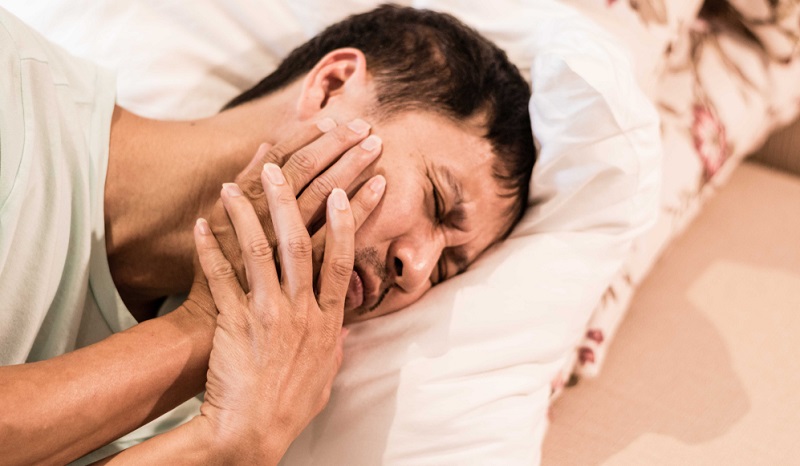TMD (Temporomandibular Disorder): Symptoms, Diagnosis, and Treatment
Contents

What is TMD?
Temporomandibular disorders (TMD) cause chronic facial pain due to issues with the jaw muscles, temporomandibular joints (TMJs), and nerves. While "TMJ" refers to the jaw joint, "TMD" describes the dysfunction of this joint.
TMJs, located just in front of your ears, connect the lower jaw to the skull and assist in chewing and speaking. TMD affects 5-12% of adults, with women and those assigned female at birth being twice as likely to experience it. The condition is most common in individuals aged 20 to 40.
TMD is classified into three types:
Joint problems
Chewing muscle issues
Headaches caused by TMD
TMD is Classified as Follows:
1. Myofascial pain syndrome
TMD in this kind is the most common. It causes discomfort or soreness in the fascia (the connective tissue that covers the muscles) and the muscles that control the function of the jaw, neck, and shoulders.
2. Joint derangement on the inside
This includes a dislocated jaw or displaced disc (the cartilage cushion between the head of the jaw bone and the skull) and an injury to the condyle (the rounded end of the jaw bone that articulates with the temporal skull bone).
3. The illness of degenerative joints
This includes jaw osteoarthritis or rheumatoid arthritis. The illness of degenerative joints. This includes jaw osteoarthritis or rheumatoid arthritis.
One or more of these circumstances may exist concurrently.
What are the Symptoms and Indicators of TMD?
TMD's most common signs and symptoms are as follows:
Jaw stiffness or soreness (usually worse in the morning or late afternoon)
Headaches
Pain behind the eyes, across the face, shoulder, neck, and/or back
Earaches or ringing in the ears that are not due to an infection of the inner ear canal
The jaw clicking or popping
Jaw locking
Mouth motions are restricted.
Teeth Grinding or clenching of the teeth
Dizziness
Tooth sensitivity in the absence of an oral health disease
Finger numbness or tingling sensation
a difference in how the upper and lower teeth fit together
TMD symptoms can mimic those of other conditions or medical concerns.
How Is TMD Diagnosed?
- Many other disorders, such as dental decay, sinus difficulties, arthritis, or gum disease, elicit comparable symptoms.
- The dentist will ask about your medical history and perform a physical exam to determine what's affecting yours.
- They'll look for soreness or tenderness in your jaw joints and listen for clicks, pops, or grating sounds when you move them.
- They will also ensure that your jaw functions properly and does not lock when you open or close your mouth. They will also examine your bite and facial muscles for any issues.
- To rule out other concerns, your dentist may take full-face X-rays to examine your jaws, temporomandibular joints, and teeth.
- Other tests, such as magnetic resonance imaging (MRI) or computer tomography (CT), may be required.
- The MRI can determine whether or not the TMJ disc is in the right place while your jaw moves. A CT scan reveals the joint's bony details.
How to Treat TMD (Temporomandibular Joints)?
Before starting treatment for TMD, note the following:
Normal Sounds: It's common for TMJs to make noises without causing discomfort, and these sounds usually don’t require treatment.
Self-Resolution: Many TMD symptoms resolve on their own. Specialists often recommend avoiding treatments that cause permanent changes to the jaw joints, teeth, or bite, or involve surgery due to the lack of conclusive evidence.
Initial TMD Treatments:
Diet: Stick to soft foods.
Heat/Cold Therapy: Apply heat or cold to your face while performing jaw exercises to stretch and strengthen the muscles.
Over-the-counter Medications: Use NSAIDs like ibuprofen to relieve pain.
Habit Reduction: Avoid jaw clenching, gum chewing, and nail biting.
Medications:
NSAIDs: For pain relief.
Prescription Medications: Antianxiety drugs, antidepressants, antiepileptics, and opioids. Note that some medications can be addictive or have serious side effects. Always follow your doctor's instructions on use.
If these methods do not help, or if your doctor/dentist diagnoses a specific type of TMD while you are trying them, one or more of the following treatments may be advised.
1. TENS stands for transcutaneous electrical nerve stimulation.
This therapy employs low-level electrical currents to relax your jaw joint and facial muscles, thereby relieving pain.
It is possible to do it at the dentist's office or at home.
2. Ultrasound.
Deep heat administered to the joint can alleviate pain and enhance mobility.
3. Injections at trigger points.
Pain medication or anaesthesia is injected into painful facial muscles known as "trigger points" to provide relief.
4. Radiofrequency treatment.
Radio waves stimulate the joint, increasing blood flow and relieving discomfort.
5. Laser therapy at a low level.
This relieves pain and inflammation while also allowing you to move your neck and open your mouth widely.
6. TMD surgical procedure
Conclusion
Discovering the intricacies of Temporomandibular Disorder (TMD) sheds light on its profound impact. With jaw stiffness, headaches, and restricted motions, TMD's effects can be debilitating.
Seeking professional advice and exploring various treatments can unlock the path to relief, restoring harmony to your jaw and smile.
Let's embark on a journey towards a pain-free life together!


